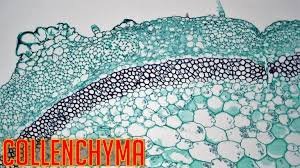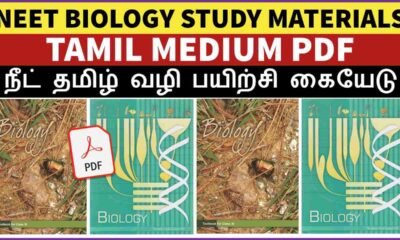Blog
Collenchyma Tissue Characteristics, Types and Functions | Free Biology Notes

This article we will discuss about Collenchyma Tissue Characteristics, Types and Functions
Collenchyma Tissue Characteristics
- Collenchyma are living mechanical tissue
- The shape of collenchyma cell can be variable. It may be oval, spherical, round or polygonal
- Cell wall contains cellulose, hemicelluloses and pectic materials
- Cellulose, hemicellulose and pectin are deposited at the corners of cell
- Found in under the epidermis of young stems, leaf veins, leaf margins and petiole
- Collenchyma is absent in mature plant parts, roots and monocots
- Intercellular spaces are absent and cells are compactly arranged
Types of collenchyma tissue
Depending upon the pattern of wall thickening and cell arrangement and their location, the collenchyma tissues are classified into following types.
Angular collenchyma
- Most common type of collenchyma tissue
- Intercellular spaces absent
- Cell wall deposition occur at corners of cells
- E.g. Solanum
Lacunar collenchyma
- Cells posses large intercellular spaces
- Cell wall deposition occur on walls which are in front of intercellular spaces
- E.g. Cucurbita stems and areal roots of monsteria
Lamellar collenchyma
- Cells are closely arranged horizontal line
- Cell wall deposition occur on parallel cell surface (tangential walls)
- E.g. Sunflower stem
Function of collenchyma
- Collenchyma gives mechanical support to the young dicot plants
- They are more flexible tissue
- Collenchyma with chloroplasts can perform photosynthesis
- Collenchyma together with parenchyma and sclerenchyma provides extra strength to the plants at different stages of development
- Leaves are not teared in high velocity of wind because they have collenchyma tissue

 Entertainment1 month ago
Entertainment1 month agoIbomma Bappam: Redefines Telugu Streaming Trend

 Blog2 months ago
Blog2 months ago[PPT] The living world Class 11 Notes

 Blog2 months ago
Blog2 months ago[PPT] Human Reproduction Class 12 Notes
- Blog2 months ago
PG TRB Botany Study Material PDF Free Download

 Blog1 month ago
Blog1 month agoIosmirror.cc Apk: Enables Smart Screen Sharing
- Blog2 months ago
Class 12 Biology Notes Chapter wise PPT
- Blog2 months ago
Class 11 Biology Notes Chapter wise PPT

 Blog2 months ago
Blog2 months agoDownload NEET Biology Study Materials in Tamil












